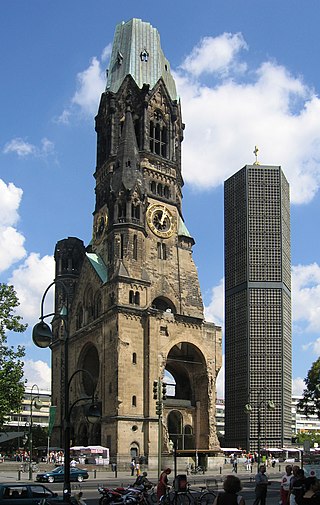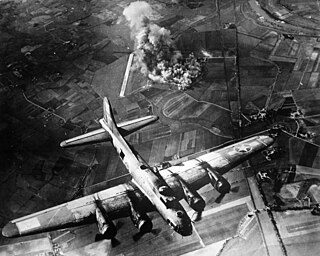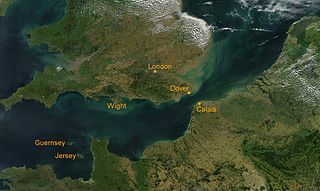
The Battle of Britain was a military campaign of the Second World War, in which the Royal Air Force (RAF) and the Fleet Air Arm (FAA) of the Royal Navy defended the United Kingdom (UK) against large-scale attacks by Nazi Germany's air force, the Luftwaffe. It was the first major military campaign fought entirely by air forces. The British officially recognise the battle's duration as being from 10 July until 31 October 1940, which overlaps the period of large-scale night attacks known as the Blitz, that lasted from 7 September 1940 to 11 May 1941. German historians do not follow this subdivision and regard the battle as a single campaign lasting from July 1940 to May 1941, including the Blitz.

The Blitz was a German bombing campaign against the United Kingdom, in 1940 and 1941, during the Second World War. The term was first used by the British press and originated from the term Blitzkrieg, the German word meaning 'lightning war'.
Bomber Command is an organisational military unit, generally subordinate to the air force of a country. The best known were in Britain and the United States. A Bomber Command is generally used for strategic bombing, and is composed of bombers.

RAF Fighter Command was one of the commands of the Royal Air Force. It was formed in 1936 to allow more specialised control of fighter aircraft. It served throughout the Second World War. It earned near-immortal fame during the Battle of Britain in 1940, when the Few held off the Luftwaffe attack on Britain. The Command continued until 17 November 1943, when it was disbanded and the RAF fighter force was split into two categories; defence and attack. The defensive force became Air Defence of Great Britain (ADGB) and the offensive force became the RAF Second Tactical Air Force. Air Defence of Great Britain was renamed back to Fighter Command in October 1944 and continued to provide defensive patrols around Great Britain. It was disbanded for the second time in 1968, when it was subsumed into the new Strike Command.

The Channel Dash was a German naval operation during the Second World War. A Kriegsmarine squadron comprising the two Scharnhorst-class battleships, the heavy cruiser Prinz Eugen and their escorts was evacuated from Brest in Brittany to German ports. Scharnhorst and Gneisenau had arrived in Brest on 22 March 1941 after the success of Operation Berlin in the Atlantic. More raids were planned and the ships were refitted at Brest. The ships were a threat to Allied trans-Atlantic convoys and RAF Bomber Command attacked them from 30 March 1941. Gneisenau was hit on 6 April 1941 and Scharnhorst on 24 July 1941, after dispersal to La Pallice. In late 1941, Adolf Hitler ordered the Oberkommando der Marine to plan an operation to return the ships to German bases against a British invasion of Norway. The short route up the English Channel was preferred to a detour around the British Isles for surprise and air cover by the Luftwaffe and on 12 January 1942, Hitler gave orders for the operation.

Wilhelm Hugo Sperrle, also known as Hugo Sperrle, was a German military aviator in World War I and a Generalfeldmarschall in the Luftwaffe during World War II.

The RAF Advanced Air Striking Force (AASF) comprised the light bombers of 1 Group RAF Bomber Command, which took part in the Battle of France during the Second World War. Before hostilities began, it had been agreed between the United Kingdom and France that in case of war, the short-range aircraft of Bomber Command would move to French airfields to operate against targets in Nazi Germany. The AASF was formed on 24 August 1939 from the ten squadrons of Fairey Battle light bombers of 1 Group under the command of Air Vice-Marshal Patrick Playfair and was dispatched to airfields in the Rheims area on 2 September 1939.

The Pointblank directive authorised the initiation of Operation Pointblank, the code name for the part of the Allied Combined Bomber Offensive intended to cripple or destroy the German aircraft fighter strength, thus drawing it away from frontline operations and ensuring it would not be an obstacle to the invasion of Northwest Europe. The Pointblank directive of 14 June 1943 ordered RAF Bomber Command and the U.S. Eighth Air Force to bomb specific targets such as aircraft factories, and the order was confirmed when Allied leaders met at the Quebec Conference in August 1943. Up to that point, the RAF and USAAF had mostly been attacking the German industry in their own way – the British by broad night attacks on industrial areas, and the US in "precision attacks" by day on specific targets. The operational execution of the Directive was left to the commanders of the forces. As such, even after the directive, the British continued their night attacks. The majority of the attacks on German fighter production and combat with the fighters were conducted by the USAAF.
Big Week or Operation Argument was a sequence of raids by the United States Army Air Forces and RAF Bomber Command from 20 to 25 February 1944, as part of the Combined Bomber Offensive against Nazi Germany. The planners intended to attack the German aircraft industry to lure the Luftwaffe into a decisive battle where the Luftwaffe could be damaged so badly that the Allies would achieve air superiority and would ensure success of the Normandy landings later in 1944.

The Schweinfurt–Regensburg mission was a strategic bombing mission during World War II carried out by Boeing B-17 Flying Fortress heavy bombers of the US Army Air Forces on August 17, 1943. The mission was an ambitious plan to cripple the German aircraft industry; it was also known as the "double-strike mission" because it entailed two large forces of bombers attacking separate targets in order to disperse fighter reaction by the Luftwaffe. It was also the first American shuttle mission, in which all or part of a mission landed at a different field and later bombed another target before returning to its base.

The Battle of Berlin was a bombing campaign against Berlin by RAF Bomber Command along with raids on other German cities to keep German defences dispersed. Air Chief Marshal Sir Arthur Harris, Air Officer Commanding-in-Chief (AOC-in-C) Bomber Command, believed that "We can wreck Berlin from end to end if the USAAF come in with us. It will cost us between 400 and 500 aircraft. It will cost Germany the war".

The Combined Bomber Offensive (CBO) was an Allied offensive of strategic bombing during World War II in Europe. The primary portion of the CBO was directed against Luftwaffe targets which was the highest priority from June 1943 to 1 April 1944. The subsequent highest priority campaigns were against V-weapon installations and petroleum, oil, and lubrication (POL) plants. Additional CBO targets included railyards and other transportation targets, particularly prior to the invasion of Normandy and, along with army equipment, in the final stages of the war in Europe.

The Defence of the Reich is the name given to the strategic defensive aerial campaign fought by the Luftwaffe of Nazi Germany over German-occupied Europe and Germany during World War II. Its aim was to prevent the destruction of German civilians, military and civil industries by the Western Allies. The day and night air battles over Germany during the war involved thousands of aircraft, units and aerial engagements to counter the Allied strategic bombing campaign. The campaign was one of the longest in the history of aerial warfare and with the Battle of the Atlantic and the Allied Blockade of Germany was the longest of the war. The Luftwaffe fighter force defended the airspace of German-occupied territory against attack, first by RAF Bomber Command and then against the United States Army Air Forces (USAAF) in the Combined Bomber Offensive.

Battle of Britain Day, 15 September 1940, is the day on which a large-scale aerial battle in the Battle of Britain took place.
Code words used by the Royal Air Force during the Second World War:

The Battle of the Heligoland Bight was the first "named" air battle of the Second World War, which began the longest air campaign of the war on 3 September 1939, the Defence of the Reich. After the declaration of war, RAF Bomber Command began operations against Nazi Germany but limited their attacks to those targets that were purely military and had little risk of civilian casualties. This largely limited their efforts to attacks on the Kriegsmarine warships in German ports to prevent their use in the Battle of the Atlantic.

Unternehmen Donnerkeil was the codename for a German military operation of the Second World War. Donnerkeil was an air superiority operation in support of Operation Cerberus, also known as the Channel Dash by the Kriegsmarine.

No. 485 (NZ) Squadron was a fighter squadron established for service during the Second World War. It was the first New Zealand squadron formed under Article XV of the Empire Air Training Plan. Although many of its flying personnel were largely drawn from the Royal New Zealand Air Force, the squadron served in Europe under the operational and administrative command of the Royal Air Force.

Ramrod 16 was an attempt by the Royal Air Force (RAF) to bomb the Koninklijke Hoogovens steelworks at IJmuiden in the Netherlands during the Second World War. After several recent abortive attacks a more elaborate plan was made for six Douglas Boston IIIA light bombers of 107 Squadron to attack again, with a Ramrod as a diversion. Ramrod 16 was to be flown by twelve Lockheed Ventura Mk II bombers of No. 487 Squadron RNZAF against the Hemweg power station in Amsterdam, not far upriver from IJmuiden.
A strategic bombing campaign was waged by RAF Bomber Command against Nazi Germany and other Axis powers in Europe during the Second World War. Relatively few of these were daylight operations and the vast majority of these sorties were flown at night. After suffering heavy losses attempting daylight bombing raids over the Heligoland islands in the North Sea and over France during the first half of 1940, Bomber Command had largely withdrawn its aircraft from daylight attacks. Bomber Command, however, was still willing to risk aircraft to attack targets in daylight on occasion. These were usually targets that required highly precise delivery of bombs, such as warships or small factories. Industries located in occupied territories were another group of targets that required a high degree of accuracy when attacked to avoid casualties among the civilians of the occupied country.















